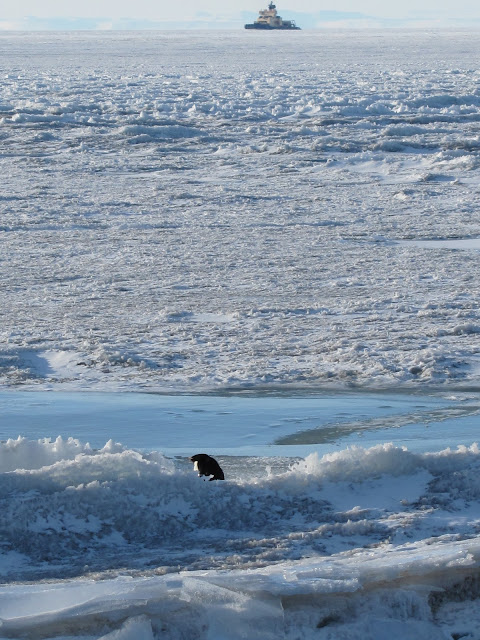The break in posting here may be the best evidence of the exhaustion setting in. Long hours of generally routine work, sleep at what used to be a foreign hour, and not as many peak experiences; that about sums it up. I have just less than a month to go on the Ice. I'm due to fly out on a Boeing 757 on February 23rd, weather willing. As the season proceeds, the weather gets chancier. Iffiier. Dicier. Kathi is to fly into Cheech on March 1st, giving us a cushion in case the weather proves to be antarctic.
Almost a week ago I was driving an Airfield Shuttle from McMurdo to Pegasus when I came across 3 Emperors standing in the middle of the road. The middle of the road! And they were none too eager to move. It actually gave me a wonderful excuse to stop and photograph from the van window. In a few minutes they moved a bit out of the lane and towards the adjacent one where the Galley truck was coming up. (The Galley truck carries out food to the Galley at Pegasus for those folks who are working out there during meal times.) The Emperors waddled up fairly close to the Galley workers who had spilled out of the truck to take photos. When I could no longer keep my passengers waiting, off I drive.
 |
| My favorite photo. |
 |
| Note the tire marks. |
The weather whipsaws back and forth and there's no way yet to know from day to day what it will be or how to dress. Weather forecasts? Nah, the best they seem to be able to do is to tell you what it is outside at the moment. "You don't need a weather man to know which way the wind blows." But it has presented some interesting situations.
Last night I was working as airfield taxi, which means I was there all night waiting for LC-130s to come in so that I could transport the flight crews from their planes to the airfield shuttle, who would take them in the almost hour-long trip back to McMurdo. Only the taxi can come on the apron and approach the plane, after clearance from MC1. It's usually a great place to get a lot of reading done for the 7 hours out there. While out retrieving a flight crew back from the South Pole, a tendril of fog came in and visibility went to near zero in minutes. If I didn't have a good sense of direction, it would have been impossible to move and get back to the Galley area. After it had mostly cleared, Mac-Ops called a Condition 2 for the area, restricting movement.
 |
| Makes me think of the closing scene in "Casablanca." |
I'm left wondering how they can take off and land in this sort of fog. And this was the 146th flight that they've done this year to the Pole, their busiest destination.
After work I volunteered to take a group of people half way back on the Pegasus Road to Half Way House to see the group of molting Emperor penguins. An exceptionally nice group of people, including 2 Chinese scientists, Zhibin Yu and Weitao Hunag, that I've become friends with. The temperature difference between McMurdo and the ice shelf was dramatically extreme. People who had asked me about having to take their ECW gear were glad they had it. Some retreated to the van fairly quickly. But the experience was wonderful. Consider that this is only a few hours after the pea soup fog at Pegasus. The views were startlingly clear, diamond clarity.
When their feathers molt, they need to avoid swimming until the new feathers come and get coated with a waterproof layer. That allows the feathers to insulate them when they go diving. For Emperors the process can take 34 days. Not being able to swim means not being able to eat and they rely on their blubber reserves. They seem to like this particular spot because Fuels has built a large berm to hold an intermediate pump, which the penguins use to get out of the wind with their diminished insulation.
 |
| Emperors with Ob Hill in the left background. McMurdo is on the far side of that ridge. |
 |
| Emperors with Mt. Erebus in the background. Almost no steaming from the crater. |
 |
| When they spread their wings and stretch out their necks, you almost expect them to burst into spontaneous song and dance. An Antarctic Bollywood. Silly. I know. |
 |
| Weddells basking. |
 |
| Weddell surfacing in an open water break. |


























































